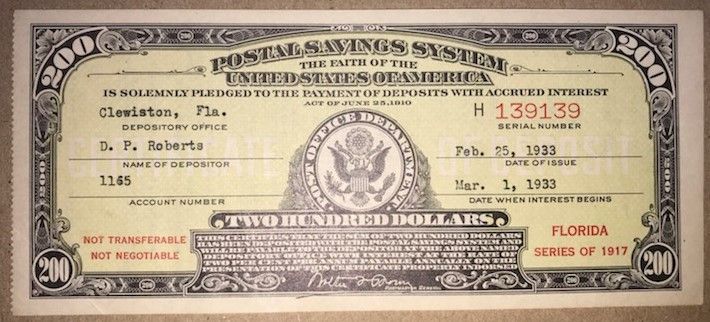Beautiful uncancelled $200 Postal Savings System Note from the Post office Department of the United States of America issued in 1937. This historic document and has an ornate border around it with a vignette of the U.S. Seal. This item has the printed signature of the Postmaster General, and is over 82 years old. Uncirculated condition. 
Certificate An Act of Congress of June 25, 1910, established the Postal Savings System in designated Post Offices, effective January 1, 1911. The legislation aimed to get money out of hiding, attract the savings of immigrants accustomed to saving at Post Offices in their native countries, provide safe depositories for people who had lost confidence in banks, and furnish more convenient depositories for working people. Although bankers first viewed the Postal Savings System as competition, they later were convinced that the Postal Savings System brought a considerable amount of money out of hiding from mattresses and cookie jars. The law establishing the Postal Savings System directed the Post Office Department to redeposit most of the money in the system in local banks, where it earned 2.5 percent interest. The Postal Savings System paid 2 percent interest per year on deposits. The half percent difference in interest was intended to pay for the operation of the system. Certificates were issued to depositors as proof of their deposit in the Postal Savings System. Interest was compounded annually on all certificates issued on or after September 1, 1954, although simple interest continued to be paid on certificates issued before that date. The initial maximum allowable balance of $500 was raised to $1,000 in 1916 and to $2,500 in 1918. The initial minimum deposit was one dollar. In order to save smaller amounts for deposit, customers could purchase a 10-cent postal savings card and 10-cent postal savings stamps to fill it. The card could be used to open or add to an account when its value, together with any attached stamps, amounted to one or more dollars, or it could be redeemed for cash. Initially certificates of deposit were issued in denominations of $1, $2, $5, $10, $20, $50, and $100. Until May 1916, there was a monthly deposit cap of $100. Beginning in July 1917, certificates were also issued in the amounts of $200 and $500. Beginning September 1, 1954, when new punchcard-style certificates were issued, $1,000 and $2,500 denominations were added, and the $2 denomination was dropped. The $1 denomination was dropped in August 1956, when the minimum deposit was raised to $5. From July 1, 1911, to July 1, 1935, Postal Savings System deposits could be exchanged in amounts of $20 or more for postal savings bonds, which yielded 2.5 percent interest. After July 1, 1935, customers could purchase U.S. savings bonds in lieu of postal savings bonds. Beginning in 1940, postal savings stamps were also issued in 25-cent, 50-cent, and 1-dollar denominations. In 1941, a 5-dollar denomination was added, and while still redeemable for certificates of deposit, the stamps were meant to be pasted into booklets which were redeemable for United States Treasury Defense savings bonds. Deposits were slow at first, but by 1929, $153 million was on deposit. Savings spurted to $1.2 billion during the 1930s and jumped again during World War II, peaking in 1947 at almost $3.4 billion, with more than four million depositors using 8,141 postal units. The large increase during the war was attributed to the shortage of goods for purchase, the drop in bank interest rates to one percent or less, and the convenience offered by familiar Post Offices to people working long hours and displaced from their permanent homes. After World War II, goods became available to meet pent-up consumer demand, banks raised their interest rates to two percent or higher and offered the same government guarantee as the Postal Savings System, and savings bonds provided a higher rate of interest. Deposits in the Postal Savings System declined, dropping to $416 million by 1964. On April 27, 1966, the Post Office Department stopped accepting deposits to existing accounts, refused to open new accounts, and cut off interest payments as the yearly anniversary date of existing accounts came up. The Postal Savings System ended officially on July 1, 1967. History from United States Post Office and OldCompany.com (old stock certificate research service)

Certificate
For more information about buying and selling Postal Savings Certificates please see United States Postal Savings System








